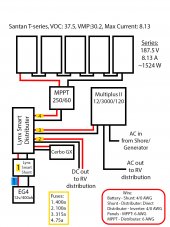dab1294
New Member
- Joined
- Aug 21, 2022
- Messages
- 24
So I am working on designing my first system. The project is an off-grid 17ft camper in AZ, just south of the Grand Canyon. Here is a photo of what I have come up with so far, but I do have a lot of questions.

So here are my questions:

So here are my questions:
- What wire sizes/fuses should I be using for this system. I think I have a rough idea but with this being my first system I want to be sure.
- I want this project to be scalable if needed. Could I add another 5-panel series (5s2p) and another 400 amp-hour battery without having to change anything else in the system?
- How should this system be grounded? Do each of the components have an equipment ground?
- If the EG4 has a breaker on the front, is a main fuse and battery disconnect still necessary?
- Can DC power be wired directly from the Lynx distributer to the DC distribution in my camper?
- Is the Cerbo necesary? What is the most cost-effective way for me to be able to monitor this system, preferably from off site? We will have Starlink, and I plan on setting it up to have back up power available totally separate from the system.
- Is a disconnect between the panels and MPPT recommended? Should there be a fuse in between those as well?


